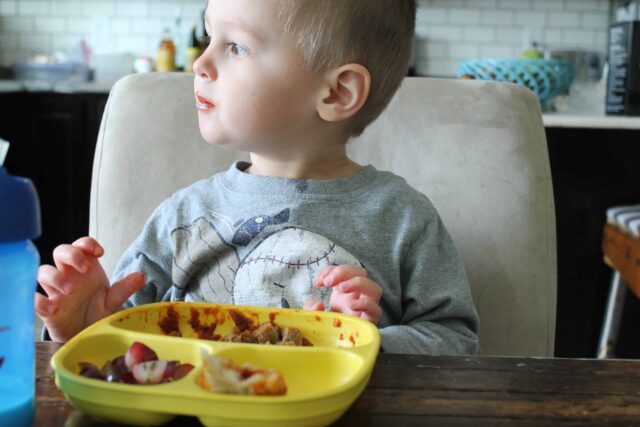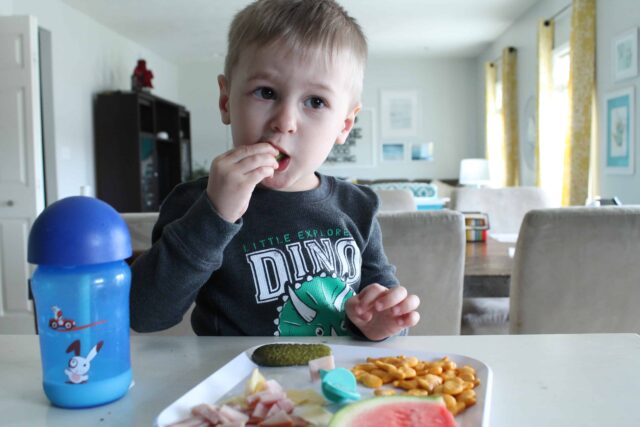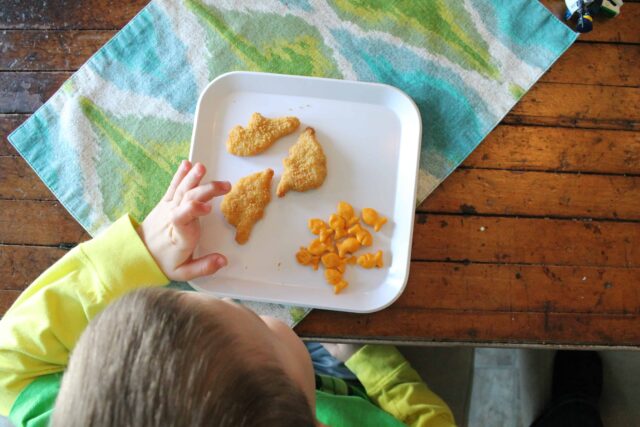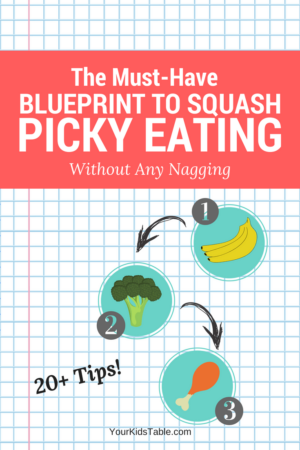Learn how to help your child or toddler with picky eating. Get practical tips and strategies you can start today for the picky eater in your life!
At birthday parties, in the grocery store, and over coffee I hear parents everywhere talking about the lack of food their child eats. Sometimes their voices are strained with stress and fatigue from one-too-many meals that have ended in tears and frustration. They worry their child isn’t getting enough nutrition, calories, or that they may never learn to eat well.
Other times I can hear nothing but total apathy in their tone, usually the next emotion-less phase, as they’ve been forced to accept that there’s nothing that can be done about their child’s relentless picky eating.
But, what if I told you that’s a myth you don’t have to buy into. What if there are real ways to help your child overcome picky eating and learn to enjoy new foods?
It’s true, as hard as that may be to believe, that you can even reverse picky eating with the right strategies!
Not only have I lived it with my own extreme picky eating son, but as a feeding therapist and online teacher I’ve helped hundreds of other parents too. If you’ve been to Your Kid’s Table before you know that I talk a lot about picky eating, and besides my online picky eating class, I have tons of resources here. But, in this post, I’m pulling them all together as a road map for YOU, whether you have a mild picky eater that isn’t interested in their veggies or one that has a total of three foods in their diet.
Before we get to the ending-picky-eating tips, we’ve got to talk about why kids (and even some adults) are picky eaters…
Is it the Parents Fault? Why Kids are Picky Eaters
It’s common for parents to blame themselves for their child’s picky eating, it’s hard not to when there’s seemingly no explanation for why kid’s won’t eat a larger variety of foods. But blaming yourself will keep you from moving forward and is just another picky eating myth.
The truth is that for the majority of kids picky eating is a normal part of development.
This happens for a variety of reasons, including changing taste buds that are way more sensitive than ours, a developmental need to exert some independence, and an instinctive fear of the unknown (aka new foods). Typical picky eating usually sets in sometime between 1 and 2 years old. It often lasts until around 3-5 years of age.
But – and this is a big BUT – there are many other factors that can make picky eating much worse, or make it a permanent way of life, which include things like: (click the links for more info)
- Oral motor weakness/poor coordination (how kids chew and move food around in their mouth)
- Sensory processing “issues” (the way food tastes, looks, smells, and feels)
- Underlying medical difficulties (think acid reflux and allergies that can easily be missed)
Head over to Why Kids Refuse to Eat to learn even more!
So… Won’t They Just Grow Out of Picky Eating???
Well, maybe, and a lot of the time yes, but the chances of that decrease if any of the underlying difficulties I listed above are present. Or, other times what once were normal picky eating issues can snowball into something much bigger and more long lasting. This often happens when parents are given bad advice, or a few essential strategies to keep picky eating to a minimum aren’t in place (we’ll talk about those in a minute).
While I don’t want any parent to panic, I do think being proactive is important. Hundreds of times over I’ve heard from parents of children now labeled with Avoidant Restrictive Food Intake Disorder (ARFID), Selective Eating Disorder (SED), and Extreme Picky Eating that they were told from doctors, “Don’t worry, they’ll grow out of it.”
But, the day never comes for some kids. Find out more about if and when they might here.
That’s what we all want to avoid, right? The tips you’ll learn below will help you prevent that from happening, or help you turn around severe picky eating.
Thinking About Picky Eating Differently
One of the most pivotal moves you can make in helping your child overcome picky eating is to begin to think about meals in a whole new way. I’ll warn you that this does require a mindset shift, as it goes against the way most of us were raised. But, Ellyn Satter’s fantastic research has shown that not pressuring kids to eat is a simple and powerful strategy that teaches your child how to have a healthy relationship with food throughout their entire life.
This key strategy is something I talk about in my free picky eating workshop (if you haven’t watched it, get a spot here!) because for me it’s the foundation for every other little tip and trick I can give you.
And, while it’s simple, it’s not always easy. Not pressuring our kids to eat involves not begging, bribing, rewarding, forcing, or distracting them so that they’ll eat.
It means putting the food in front of them, and allowing them to decide how much and whether they eat it. If you think about it, they’re really in control of this anyways – and they know it! Stopping the power struggle gives them the freedom to experiment with trying new foods without feeling like they’re under a microscope.
Before you shout at me, “This is bologna!” Here me out. I’m not suggesting we give kids free reign over their meals. There’s a critical balance to strike.
To overcome picky eating you must…
And, part of that balance is not allowing your child to choose their meals. That doesn’t mean to serve a fancy souffle with a side of field greens for dinner and expect them to eat it. It does mean to include at least one food that they eat most of the time and serve them other foods that the rest of the family are eating.
I could go on and on about this valuable picky eating tip, but we’ve got more to cover. If you want to read more head over to the Best Picky Eating Strategy.
In addition to the no pressure eating environment, it’s time to think about your mealtime structure, as this can have an enormous impact on what your child is willing to eat:
- Eat meals at a table with no grazing on food in between. Snacks are okay, but treat them as mini-meals that you sit down for.
- Eat together as often as possible. Not only does this make eating way more enjoyable, it also exposes our kids to more foods and models a varied diet. It may seem like they’re not paying attention, but they are!
- Serve milk and juice with meals. Have water available for in between meals. You’d be surprised how some milk can spoil their appetite. If you’re in the toddler years and aren’t sure how much milk your kiddo should be drinking then check out How Much Milk Does A Toddler Need.
- Avoid using tablets, tv, toys, and books at the table because they aren’t actively eating. It’s like they’re on auto pilot and that means it’s very hard to make improvements in their diet. It can be a SLOW process weaning them off distractions if you’re currently relying on this to help your child eat. Read more at Screen time and Eating.
Affiliate links used below. See our full disclosure.
Kick it Up a Notch! More Tips for Picky Eating…
My Mealtime Works students will tell you that what you’ve learned so far are some of the foundation strategies for conquering picky eating (get a free printable of these tips here), but there’s some more advanced tips and tricks you can include too. I’d only start working on these once you’ve got what you learned above under your belt though.
1. Use dips – yes even if your picky eater seemingly hates dips. Think about the popular kid favorites like ketchup and ranch, but don’t be afraid to think outside of the box! I once worked with a kiddo that learned to enjoy all sorts of veggies with red wine vinegar.
Once kids learn to accept them they can mask the texture and flavor of new foods, which is a great stepping stone. Read more about using dips as a picky eating strategy.
2. Expand on what your child is already eating – when it comes to picky eaters baby steps are the name of the game. And, one of the best ways to help your child learn to eat new foods is by showing them that new foods aren’t that scary. Of course, we don’t want to pressure them to try new foods so instead try offering them foods that are very similar to their favorites.
If your child has food jags (aka will only eat highly specific types of food often prepared a particular way) then you’ll want the changes to be incredibly small.
What’s amazing is that once picky eating kids learn to accept these small changes it opens them up to trying other foods. There’s a bit of systematic way to approach this though, you can find more details about this technique that’s often called food chaining here.
3. Put it on a stick – sometimes serving food in an unexpected way can peak a kid’s interest and give them the courage to try a new food. Food on skewers or using toothpicks is easy to try, but be cautious with younger children. Find more picky eater stick ideas.
4. Use divided or fun plates – divided plates are often a must for picky eaters, as it keeps food from touching. These are my personal favorite. We use them almost everyday because they’re also super functional. Besides the basic divided plates some picky eaters also respond to fun plates and utensils, which there happen to be a plethora of. This is my list of fun plates for kids that happen to be perfect for picky eaters!
5. Read books about food – I love working on picky eating outside of meals, because kids and parents alike tend to be much more relaxed. A great way to do that is to read books that have a positive message about food and teaches them about different foods.
This isn’t a miracle strategy, but every little bit helps. One caveat is to avoid books that label kids at picky eaters, it’s a label that kids don’t need.
Two of my favorites are Eating the Alphabet and Good Enough to Eat, but you can get the rest of my top picks in Children’s Books for Picky Eating.
6. Cook together – you’ve probably heard this picky eating tip before, and may even feel defeated by it, because it can be challenging just to get picky eaters help cook, but it’s worth the effort. Any interaction your child has with different foods is progress. Looking at, smelling, and touching foods are all steps picky eaters often have to take before they even think about putting it in their mouth.
Here are some recipes and guides to how I used cooking together to help my kids: spinach and cheese wafflewich (I love that this kids classic has added nutrition), carrot cake smoothies, and homemade hot pockets.
Picky Eating Troubleshooting
One thing to understand is that picky eating is a very broad term (to find out what type of picky eater your child might be click here), and it encompasses some behaviors that may seem, well, a little strange or unusual. These behaviors might leave you feeling a little stuck. This list below is your troubleshooting picky eating guide:
- Sensitive to smell – Some picky eaters are extremely sensitive to smell. So much so that they complain if something they don’t like is even on the table. Know that you’re not alone, as it’s common among picky eaters. If you’re struggling moving forward because of food smells, focus on warning your child about smells before they come to the table, or into the kitchen where you’re cooking. Better yet get them involved with the cooking because the smell is usually gradual as the food begins to cook.
I’ve got more tips for kids sensitive to smells here.
- Won’t let anything come near their mouth – Kids that have a negative experience with eating, such as gagging frequently or throwing up while eating may develop what feeding therapists often refer to as an oral aversion. This simply means that they’re highly sensitive to anything touching around or inside of their mouth.
It’s possible to break down this sensitivity, learn how in my guide on oral aversions.
- Difficulty sitting still – Probably one of the most common challenges for picky eaters. If your child won’t sit at the table, how the heck are they going to eat? Often kids need to either participate in some movement or sensory activities before a meal to help them. But, making sure meals don’t go past 30 minutes is important too.
Sometimes using some extra tools like wobble cushions and weighted lap pads can be all a child needs to keep their butt in place. Get even more strategies for kids having a hard time sitting during meals here.
- Refuses any meat – Many picky eaters struggle to accept meat because of the texture. To help your child begin to accept meat into their diet, try small, thin, and/or breaded varieties for the most likely success.
Check out How to Get Your Child to Eat Meat for additional tips.
- Won’t eat veggies – Vegetables actually taste very bitter to most kids, hence why they’re so frequently refused. It can take some time to help your child get used to veggies and many of the strategies above will help, but I like to mix or mince them into other foods or make entirely new recipes. Think sweet potato bread or zucchini pancakes.
I’ve got a list of my favorite vegetable recipes for kids, and also a list of tips in How to Get Your Child to Eat Vegetables.
- Doesn’t eat at holiday meals – Just about every picky eater can’t find something to eat at thanksgiving dinner, except for the biscuits. And, this opens the door to lots of well-meaning but usually un-helpful advice from family and friends. Plan a side dish in advance, that your child will eat, even if it’s peanut butter sandwiches and let your host know ahead of time that you’ll be bringing it.
Check out other methods for managing large family meals with picky eaters here.
- Denies any medication – This is the only time I break my not pressuring rule, and it can be very tricky to get a picky eater to take medication. I will use distractions if need be and allow them to swallow it with a piece of chocolate in their mouth because the flavor can over-ride or at least dampen the medicine taste.
Head over to How to Help Picky Eaters Take Medicine for other strategies.
Are there Special Foods for Picky Eaters?
I think one of the biggest misconceptions about picky eating is that there’s some special foods that will cure it, and I get it. It seems that if we could only find the foods they’d be willing to eat, us parents could put the picky-eating-worries behind us. At this point I hope you know that’s only part of the answer. You can leverage foods to your advantage and milder picky eaters will often respond very well to some simple, but thought-out meals.
Here are some of my favorite lists for inspiration:
- Healthy Snacks for Picky Eaters
- Meal Ideas for Picky Eaters
- Nutritious Desserts for Picky Eaters
- How to Pack a Lunch Your Child Will Eat
Want these ideas in print? I’ve got a free picky eater meal ideas printable you can snag here!
Maybe What’s Most Important for Picky Eating…
Dealing with picky eating is utterly exhausting sometimes. What you’ve learned here doesn’t have to be perfect, it needs to work for your family. Work on one strategy at a time, and give yourself plenty of room to make mistakes. If you’re feeling beaten down by this common childhood challenge take some time for yourself to re-charge so you can be patient during meals.
Patience while your child learns to eat new foods is critical, and I say this as someone that struggles with patience in all areas of life. I also say it as a mom that’s been in your shoes. Read about turning my picky eater around and get the motivation you need for patience.
And, if you’re worried about your child’s health, which can be a legitimate concern you’ll want to find out if you do in fact need to be worried at all. I’ve got you covered in Is Your Picky Eater Healthy?
Another issue that may concern you is if your child is learning how to eat nutritiously. Again, this is perfectly understandable. But, there’s actually a wrong way to help them learn about vitamins and nutrients, and it usually involves lecturing them or quilting them into eating foods that are healthy. That doesn’t mean there isn’t a place for nutrition though. Learn how to approach this sometimes difficult topic in Teaching Kids About Nutrition.
Working through your worries will help you be in the best mindset to help your child with their picky eating!
What About Picky Eating Adults?
Although I’ve only worked with children, I know some of you out there are reading this post in hope that you’ll be able to find something that will help you, yourself, a picky eating adult. While I do believe some of the tips and tricks in this post can be adapted to help you, I’m also excited to share a new resource, finally, for adults and teenagers that desperately want to move past their own picky eating struggles.
Jenny McGlothlin and Dr. Katja Rowell’s new Conquer Picky Eating for Teen and Adults is a workbook that will help you overcome your picky eating strategies. I highly recommend checking it out if you’re struggling to eat different foods and want a new way of life. You can find it here.
Getting Even More Help for Picky Eating
There’s a lot of information in this post, so much so that you’re probably going to want to re-read it. But, I want to end with giving you a few more resources. This picky eating thing can get overwhelming fast, and sometimes you need some extra help.
You can find that help in feeding therapy, which is specialized learning time for your child, usually with an occupational therapist like myself or a speech therapist. Get any questions answered in the feeding therapy guide.
And, lastly, you can also get more help from me in my free picky eating workshop: 3 Keys to Turn Around Picky Eating. This is worth your time. Print our the workbook (you’ll get it in an email once you sign up). Get a spot here.
Picky Eating Articles Not to Miss
Getting Your Picky Eater to Explore New Foods
How to Prevent Toddlers from Becoming Picky Eaters
Clever Tricks to Have a Family Meal with a Picky Eater
Did you pin this?
This is a whopper of an article, pin it to your parenting or child board to find it again quickly!
Alisha Grogan is a licensed occupational therapist and founder of Your Kid’s Table. She has over 14 years experience with expertise in sensory processing and feeding development in babies, toddlers, and children. Alisha also has 3 boys of her own at home. Learn more about her here.





